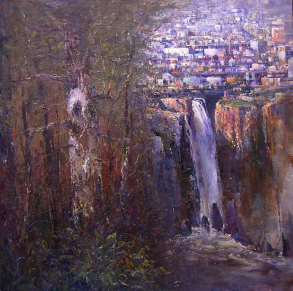This past May, I wrote a blog about the art seen on the walls of talking heads from the news shows, broadcasting from their homes since the pandemic began. My wife, who suggested that I write the post, was struck in particular by the painting on the wall by the Washington Post’s Phil Rucker.
I contacted several nightly news program guests, asking them to tell me about the artworks seen in the background, and a fair number responded. Phil graciously told me that the painting my wife liked was by Robert Andriulli, and that he had bought it at a gallery in Baltimore.

Phil’s taste evidently corresponds with that of a lot more people than just my wife, for I received several queries about Andriulli’s work from people who aren’t on my blog list but found my post while researching Phil’s painting on Google. I thought such interest merited a blog on the artist, so I tracked down Bob Andriulli and gave him a call to ask about his work.
Born in Paterson, New Jersey, in 1948, Andriulli received an M.F.A. in painting from The Pennsylvania State University. He taught at Bowdoin College, Seton Hall University, and Penn State before teaching for several years at Millersville University in Millersville, Pennsylvania, from which he retired a couple of years ago.
As an art student, Andriulli flirted with abstraction but found representation more to his taste. He really doesn’t draw a line between the two. He remembers one of his teachers telling him that one of the most important aspects of representation is its abstraction. By that, the teacher meant that a landscape painting, in addition to being the record of a place, is first and foremost an arrangement of forms and colors. (A standard trick when painting a representational work is to place it upside down on the easel every now and then; such a shift in perception lets the artist more easily ignore the subject matter and concentrate on the abstract aspects of composition and color.)
Giotto, Giorgio Morandi, Edwin Dickinson, Wayne Thiebaud – Andriulli was influenced by artists of all periods when he was starting out and gradually assimilated his influences into a style that is recognizably his own.

28 x 28 inches
Earlier in his career, Andriulli spent much of his time painting en plein air, but in recent years he has worked primarily in the studio, using the lessons he learned while painting outside as only one part of a vision that is now less site-specific and more drawn from imagination. He is particularly interested in the dynamic between city and landscape, scenes in which the natural environment is increasingly in danger of being overwhelmed by man-made structures. There’s no overt preaching about climate change or ecological catastrophe, but Andriulli’s landscapes often seem as ephemeral as the clouds that fill the sky above them.
Andriulli is represented by the Steven Scott Gallery in Baltimore and the Red Raven Art Company in Lancaster, Pennsylvania. He’s a solid painter, neither famous nor unknown, who has succeeded in making a life in the arts. That makes him a pro.
One of the people who queried me about Robert Andriulli’s paintings asked if there were prints of them available. According to Bob, he doesn’t want giclee (inkjet) prints of his paintings made, so his galleries don’t offer them. But suppose you bought one of his paintings and wanted to make money having prints made of it and selling them. Could you do so? After all, you figure, it’s my painting now; I can do what I want with it.
But you can’t, not legally. When you buy a painting from an artist, unless the bill of sale specifically says that you are purchasing the copyright, you own only the physical painting. The right to reproduce the work remains with the artist.
All of which brings to mind a recent article in the Wall Street Journal about an ugly battle between two brothers who found and owned the bones of the Tyrannosaurus Rex called “Stan,” which recently sold at Christie’s for $32 million. In their professional break-up, it was agreed that one brother would retain control of the Black Hills Institute of Geological Research in South Dakota, where Stan’s bones had resided for 28 years. The other brother would get the skeleton itself. At the time, it was estimated that the distribution would leave each brother with roughly equal value. Stan’s performance at Christie’s, however, where it brought four times its high estimate, threw the scales of the division completely off.
But it gets more complicated. In the years since Stan’s discovery, the Black Hills Institute had sold over 60 resin casts of Stan’s bones for $100,000 apiece. And the Institute had trademarked Stan’s skull. The trademark wasn’t included with allocation of Stan’s skeleton, so the brother owning the Institute can expect to make a lot of money selling reproductions in the years to come. The other brother will have to content himself with his windfall (which, I am sure, has left him quite contented). But whoever bought Stan from Christie’s is going to have to accept the fact that the Tyrannosaurus Rex inhabiting his home will be having no resin offspring, unless someone wants to buy a bootleg dinosaur.

